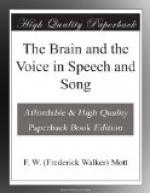The general public are becoming educated in music and are beginning to realise that shouting two or three high-pitched chest notes does not constitute dramatic singing—“a short beau moment does not compensate for a mauvais quart d’heure.” It would be hard to describe or define the qualities that make a voice appeal to the multitude. Different singers with a similar timbre of voice and register may sing the same song correctly in time, rhythm, and phrasing, and yet only one of them may produce that sympathetic quality necessary to awaken not only the intellectual but the affective side of the mind of the hearers. Undoubtedly the effects produced upon the mind by dramatic song largely depend upon circumstances and surroundings, also upon the association of ideas. Thus I was never more stirred emotionally by the human voice than upon hearing a mad Frenchman sing at my request the Marseillaise. Previously, when talking to him his eyes had lacked lustre and his physiognomy was expressionless; but when this broad-chested, six foot, burly, black-bearded maniac rolled out in a magnificent full-chested baritone voice the song that has stirred the emotions and passions of millions to their deepest depth, and aroused in some hope, in others despair, as he made the building ring with “Aux armes, citoyens, formez vos bataillons” I felt an emotional thrill down the spine and a gulp in the throat, while the heart and respirations for an instant stayed in their rhythmical course. Not only was I stirred by the effect of the sounds heard, but by the change in the personality of the singer. It awakened in my mind the scenes in the French Revolution so vividly described by Carlyle. The man’s facial expression and whole personality suddenly appeared changed; he planted his foot firmly forward on the ground, striking the attitude of a man carrying a musket, a flag, or a pike; his eyes gleamed with fire and the lack-lustre expression had changed to one of delirious excitement. A pike in his hand and a red cap on his head would have completed the picture of a sans culotte. Dramatic song therefore that does not evoke an emotional response is vox et praeterea nihil.
INDEX
A
Abductors and Adductors of Vocal cords, 30 seq.
Aikin, Dr., 33, 45, 46, 47
Classification of Consonants, 54
“The Voice,” 44
Aphasia, Motor and Sensory, 72 seq.
Articulation and phonation, 57 seq., 92, 94
seq., fig. 18
Assyria, clay records, 70
B
Ballet, 78
Bastian, Dr., 72, 78
Beethoven, symphonies, 40
Bell, Sir Charles, 97
Bouillaud, M., 68
Brain:—
How developed, 10
Localisation of Speech Centres, 72 seq.,
fig. 17
Primary Revival of Sensations, 90
Primary Site of Revival of words in Silent
thought, 80 seq.
Relation to the Voice, 61 et passim
Structure, 63 seq., figs. 15, 16,
17
Breathing, art of, 16 seq., 22, 26, 27, 94
seq.
Broadbent, Sir W., 99
Broca, 72, 76




